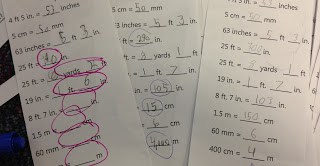I have had many people ask me questions like, “So what is a ‘typical’ day like in your math class?” or “How do you structure your math time?” These are tricky questions for me to answer because I truly do not do the same thing every day. Those of you who followed my fraction posts know that we do a LOT of whole class investigations–or at least they start off that way–but there really is a lot more to it than that!
I make decisions about how to spend my 60-80 minutes (varies depending on the schedule and the content) based on WHAT MY STUDENTS NEED THAT DAY. This is hard for some teachers to deal with . . . those who are planners, who like certain structures, and so on. I get that. I just happen to be a person who likes to work on the fly, changing flight patterns at a moment’s notice. I’m sure there is a happy medium . . . right?
So today I thought I’d walk you through my math class TODAY. We spent 65 minutes on math today, and my learning target was simple:
I can convert between units of measure.
Now, as you know, this is NOT a simple learning target and it covers a million different things which is exactly why I selected it today–because I knew I needed to tackle a million different things. Here’s how the day unfolded.
1. The students came in from specials and their bathroom break (we stop on our way back as a class to minimize interruptions in learning) and immediately got to work on an “entrance” slip to see what they have retained from the last few days. We have been working on converting units of length in both systems . . . we have drawn and built and modeled and done word problems and made charts and so on. They really should have it down. In fact, we started working on weight yesterday, so this is really to see what “stuck”. I much prefer “entrance” slips to “exit” slips.
2. As they turn them in, I grade them as quickly as possible. After a few minutes, I collect them–even if they aren’t finished. At a certain point, not being able to finish tells me about their level of proficiency. At this point, my inclusion teacher got here and finished grading and sorting while I did a quick minilesson.
3. The minilesson today involved a quick review of what the word “convert” means, a brief discussion of the types of problems we had already done over the last week or so, and then some instruction on converting between pounds, ounces, and tons. We did a few samples, talked about real world applications, and then the workshop time began!
4. Here is how the next thirty minutes unfolded. First, the inclusion teacher and I each pulled small groups based on that “entrance” slip from earlier. This has been a tough concept for many of my students, so we had 10 students that we really wanted to target. Other students were working a set of word problems I had written using different measurement conversion situations (this problem set is ALMOST ready to put it my store! Tomorrow probably!). There were 5 problems available and I let the students know which was the most rigorous. (This is an easy way to differentiate–have problems at a few levels so you can steer students who need steering!). I got up several times while my group was working to check on my problem solvers–and many were working collaboratively, checking work together, etc.
 |
| Some students got 1 or 2 problems done . . . others did all 5! |
5. The other teacher and I worked with our small groups until we felt like each member had had enough–I kept 4 of my 6 the entire time and sent the other two off to do word problems after a brief review. After I finished with my group, I started calling over other students who made errors to “proofread” their entrance slip and to tell me what they had done incorrectly. Most were careless errors that they easily found on their own.
6. As students started to finish the 5 problems, their final task was to try writing some of their own. I told them that I would use some of them in future math classes–so to work together to really come up with good situations with actual solutions!
So–this was math today! Not everyone got the “same” instruction–but everyone got what they needed! We’ll see how things go tomorrow–hopefully the small group work today made a difference!








